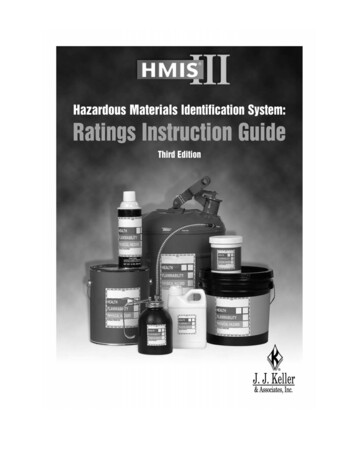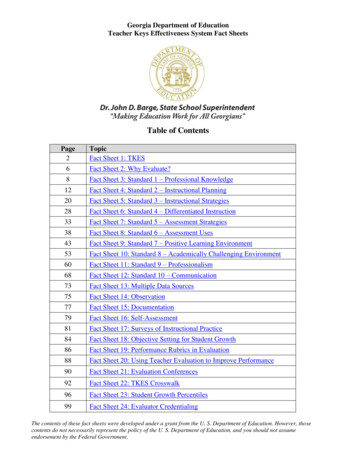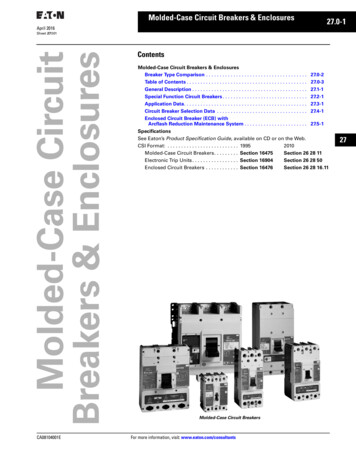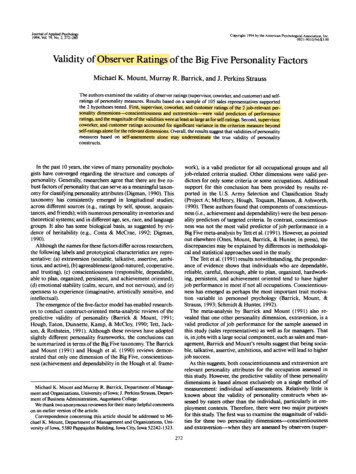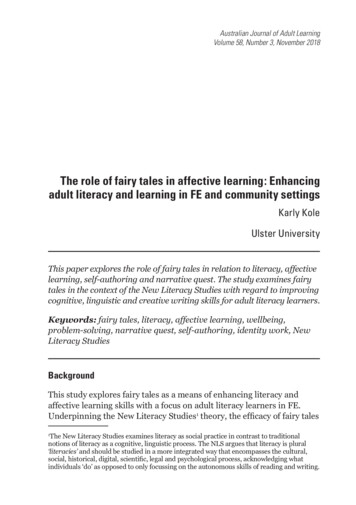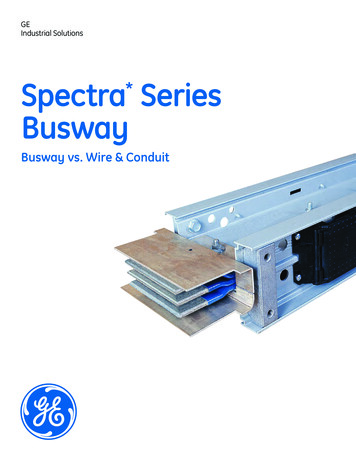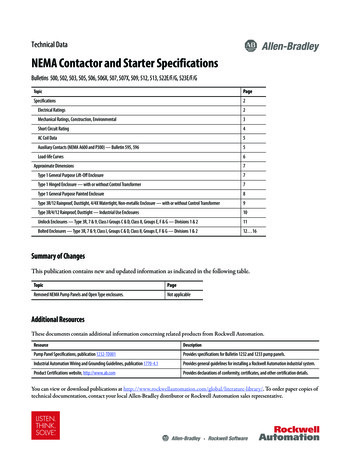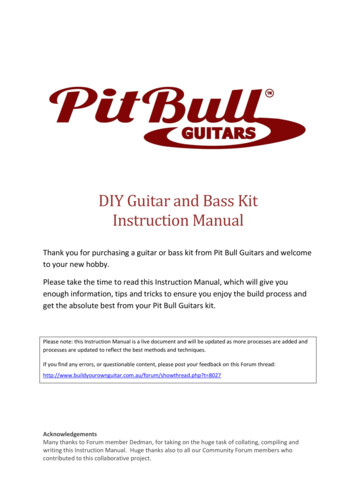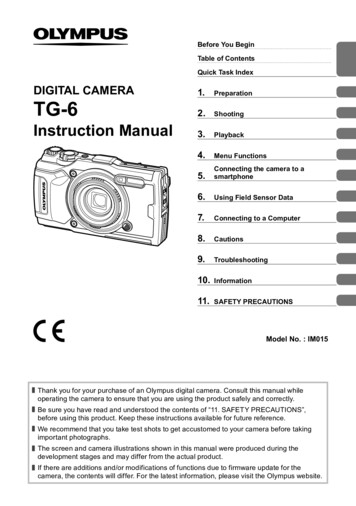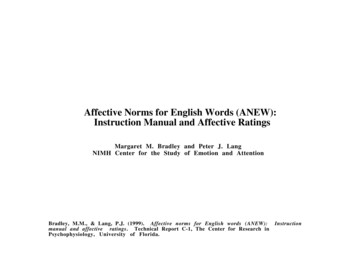
Transcription
Affective Norms for English Words (ANEW):Instruction Manual and Affective RatingsMargaret M. Bradley and Peter J. LangNIMH Center for the Study of Emotion and AttentionBradley, M.M., & Lang, P.J. (1999). Affective norms for English words (ANEW):manual and affective ratings. Technical Report C-1, The Center for Research inPsychophysiology, University of Florida.Instruction
Affective Norms for English Words (ANEW) 1999Margaret M. Bradley & Peter J. LangNIMH Center for Emotion and AttentionUniversity of FloridaIntroductionThe Affective Norms for English Words (ANEW) is beingdeveloped to provide a set of normative emotional ratings for a largenumber of words in the English language. The goal is to develop a set ofverbal materials that have been rated in terms of pleasure, arousal, anddominance to complement the existing International Affective PictureSystem (IAPS, Lang, Bradley, & Cuthbert, 1999) and InternationalAffective Digitized Sounds (IADS; Bradley & Lang, 1999), which arecollections of picture and sound stimuli, respectively, that also includethese affective ratings. The ANEW, IAPS, and IADS are beingdeveloped and distributed by NIMH Center for Emotion and Attention(CSEA) investigators Margaret Bradley and Peter Lang, in order toprovide standardized materials that are available to researchers in thestudy of emotion and attention. The existence of these affectivecollections should help in comparing results across differentinvestigations of emotion, as well as in allowing replication within andacross research labs assessing basic or applied problems in the study ofemotion.In an undertaking of this nature, choices have to be maderegarding the affective judgments used to standardize materials. Here,we began by using a relatively simple dimensional view, whichassumes that emotion can be defined as a coincidence of values on anumber of different strategic dimensions. This view is founded inOsgood's (Osgood, Suci, & Tanenbaum, 1957) seminal work with thesemantic differential in which factor analyses conducted on a widevariety of verbal judgements indicated that the variance in emotionalassessements was accounted for by three major dimensions: The twoprimary dimensions were one of affective valence (ranging frompleasant to unpleasant) and one of arousal (ranging from calm toexcited). A third, less strongly-related dimension was variously called'dominance' or 'control' . Dimensional views of emotion have beenadvocated by a large number of theorists through the years, includngWundt (1896), Mehrabian and Russell (1974), and Tellegen (1985).To assess the three dimensions of pleasure, arousal, anddominance, the Self-Assessment Manikin (SAM), an affective ratingsystem originally devised by Lang (1980) was used. Bradley and Lang(1990) determined that the SAM correlates well with factors of pleasureand arousal obtained using the longer, verbal Semantic DifferentialScale (Mehrabian and Russell, 1974. The graphic SAM figurescomprise bipolar scales that depict different values along each emotionaldimension. Figure 1 illustrates a relatively recent, scannable version ofSAM, which was used to acquire the ratings in the ANEW. For thepleasure dimension, SAM ranges from a smiling, happy figure to afrowning, unhappy figure; to represent the arousal dimension, SAMranges from an excited, wide-eyed figure to a relaxed, sleepy figure.For the dominance dimension, SAM ranges from a large figure (incontrol) to a small figure (dominated). In this version of SAM, thesubject can bubble in the location corresponding to any of the 5 figureson each scale, or between any two figures, which results in a 9-pointrating scale for each dimension. In addition to the ScanSAM version ofSAM, there is a booklet paper-and-pencil version, as well as a dynamiccomputer version written for IBM-compatible written and distributed byEd Cook1 at the University of Alabama-Birmingham (e.g., Cook,Atkinson, & Lang, 1987). The computer SAM scale uses a 20-pointscale, rendering more points along each dimension than the ScanSAMor paper-and-pencil versions.Using SAM, subjects have rated the words currently in the ANEWon the dimensions of pleasure, arousal, and dominance. Figure 2illustrates the shape of the affective space that results when each word isplotted 2-dimensional space defined by its mean pleasure and arousalrating. There are several characteristic features of the resulting space.First, these stimulus materials evoke reactions across the entire range ofeach dimension: mean pleasure ratings for these words range from veryunpleasant to very pleasant , and are distributed fairly evenly across thespace. Secondly, a wide range of arousal levels are elicited by thesematerials. For items rated as neutral in valence (i.e., those occurring atand near the midline of the valence dimension), arousal ratings do notattain the high levels associated with either pleasant or unpleasantmaterials. The distribution of the ANEW words in affective space isquite similar to that obtained with IAPS and IADS stimuli, suggestingthat this space is representative of the affective distribution of materialsfrom a number of different modalities.1 Dr. Edwin Cook, University of Alabama-Birmingham, PsychologyDepartment, 201 Campbell Hall, 1300 University Blvd., Birmingham, AL35294-1170.1
Normative rating procedure for the ANEWThis overview of the rating procedure is an example of howeach rating study was conducted. In general, each experimentpresented 100-150 different words. Each set of words was prepared ona 8 1/2 x 11 sheet of paper that presented individual words in 4 columnsand 14 rows (i.e. 56 words per sheet, see Figure 2). The words weresequentially numbered in rows from 1 to n. For each set of words, twoforms were prepared which counterbalanced the order in which anyspecific word was rated, and the items surrounding any specific word.SAM ratings of pleasure, arousal, and dominance were collected ina self-paced procedure, in which the subject silently read each word, andthen bubbled in their emotional ratings on the ScanSam sheet.Subjects. Introductory Psychology class students, balanced forgender, participated as part of a course requirement.Design. Subjects were run in groups ranging in size from 8 to25, with the male:female ratio no more than 1:2 (or 2:1) for any singlegroup session. The ScanSAM version of the SAM instrument was used(see Figure 1). In this format, the (unlabeled) dimensions of pleasure,arousal and dominance are graphically rendered, with each of the 3dimensions ordinally scaled with 5 figures. The subject can bubble in 1of 9 circles on the ScanSam sheet, with bubbles between graphic figuresindicating a level intermediate between the 2 graphically depicted levelsfor each dimension.Materials and Equipment Among the words currently includedin the ANEW are approximately 150 words used in Mehrabian &Russell (1974) and 450 words used in Bellezza, Greenwald, & Banaji,(1986).Procedure. Subjects received the sheets containing the wordsto-be-rated, and a packet of ScanSam rating sheets. Instructionsregarding ScanSam were given (see below), and each subject worked athis or her own pace rating the words in the word booklet. The sessionwas completed for all subjects within 1 hour.Instructions (ScanSam version)Thanks for coming; I appreciate your participation in this study.The study being conducted today is investigating emotion, and concernshow people respond to different types of words. You will notice thatyou have a blue packet with these figures on them (Hold up ScanSamsheet). We call this set of figures SAM, and you will be using thesefigures to rate how you felt while reading each word. SAM shows threedifferent kinds of feelings: Happy vs. Unhappy point left), Excitedvs. Calm (point middle),, and Controlled vs. In-control (pointright). You will use make all 3 ratings for each word that you readPlease notice that each of the three feelings are arrayed along adifferent scale. The left panel shows the happy-unhappy scale, whichranges from a smile to a frown. At one extreme of this scale, you arehappy, pleased, satisfied, contented, hopeful. When you feel completelyhappy you should indicate this by bubbling in the figure at the left. Theother end of the scale is when you feel completely unhappy, annoyed,unsatisfied, melancholic, despaired, or bored. You can indicate feelingcompletely unhappy by bubbling in the figure at the right. The figuresalso allow you to describe intermediate feelings of pleasure, by bubblingin any of the other pictures. If you feel completely neutral, neitherhappy nor sad, bubble in the figure in the middle (point to middleSAM figure). If your feeling of pleasure or displeasure falls betweentwo of the pictures, then bubble in the space between the figures. Thispermits you to make more finely graded ratings of how you feel inreaction to each word. There are a total of 9 possible points along eachrating scale that you can bubble in to indicate the extent to which youfelt happy or unhappy. Any questions so far?The excited or calm scale is the second type of feeling displayedhere, and it is the middle scale in the row. At one extreme of this scaleyou are stimulated, excited, frenzied, jittery, wide-awake, or aroused.When you feel completely aroused, bubble in the figure at the left of therow. Now look at the other end of the excited-calm scale, which is thecompletely opposite feeling. Here you would feel completely relaxed,calm, sluggish, dull, sleepy, or unaroused. Indicate feeling calm bybubbling in the figure at the right of the row. As with the happyunhappy scale, you can represent intermediate levels of excitedness orcalmness by bubbling in any of the other figures. If you are not excitednor at all calm, bubble in the figure in the middle of the row. Again, ifyou wish to make a more finely tuned rating of how excited or calm youfeel, bubble in the space between the pictures.The last scale of feeling which you will rate is whether you feltcontrolled or in control. This scale is on the right side of the row. Atone end of the scale (point left) you have feelings characterized ascompletely controlled, influenced, cared-for, awed, submissive, orguided. Please indicate feeling controlled by bubbling in the figure at2
the left. At the opposite end of this scale, you would bubble inthe.rightmost figure if you feel completely in control, influential,important, dominant, autonomous, or controlling. You can indicatefeeling dominant by bubbling in the figure at the right of the row. Notethat when the figure is large, you feel in control, and that it will be verysmall when you feel controlled. If you feel neither in control norcontrolled you should bubble in the middle picture. Again, you canbubble in any of the intermediate figures, or between them.When you have made all 3 ratings for each word, you will haveone bubble in each section, to make 3 bubbles in the row. Anyquestions?Please work at a rapid place and don’t spend too much timethinking about each word. Rather, make your ratings based on your firstand immediate reaction as you read each word. When you are finishedplease sit quietly and wait until the rest of the group has finished.Figures and TablesReferencesBellezza, F. S., Greenwald, A.G., & Banaji, Mahzarin, R. (1986). Wordshigh and low in pleasantness as rated by male and female collegestudents. Behavior Research Methods, Instruments &Computers, Vol 18, 299-303.Bradley, M. M., & Lang, P. J. (1994). Measuring emotion: The selfassessment manikin and the semantic differential. Journal ofBehavioral Therapy and Experimental Psychiatry, 25, 49-59.Cook, E. W., III, Atkinson, L., & Lang, K. G. (1987). Stimulus controland data acquisition for IBM PCs and compatibles.Psychophysiology, 24, 726-727.Kucera, H., & Francis, W. N. (1967). Computational analysis ofpresent-day American english. Providence, RI: BrownUniversity Press.Table 1. Means and standard deviations for pleasure, arousal, anddominance ratings for each word currently rated in the ANEW, averagedacross all subjects. The final column lists the word frequency, takenfrom Kucera and Francis (1967) norms, and is the number of times theword appeared in the data base that Kucera and Francis used. A highernumber indicates a more frequent word.Lang, P. J. (1980). Behavioral treatment and bio-behavioral assessment:Computer applications. In J. B. Sidowski, J. H. Johnson, & T. A.Williams (Eds.), Technology in mental health care deliverysystems (pp. 119-137). Norwood, NJ: Ablex Publishing.Mehrabian, A., & Russell, J. A. (1974). An approach to environmentalpsychology. Cambridge, MA: MIT Press.Table 2. Means and standard deviations for pleasure, arousal, anddominance ratings for each word currently rated in the ANEW, for malesubjects. The final column lists word frequency, from Kucera andFrancis (1967).Osgood, C., Suci, G., & Tannenbaum, P. (1957). The measurement ofmeaning. Urbana, IL: University of Illinois.Table 3. Means and standard deviations for pleasure, arousal, anddominance ratings for each word currently rated in the ANEW, forfemale subjects. The final column lists word frequency, from Kuceraand Francis (1967).Figure 1. ScanSAM sheet illustrating computer scorable form ofSAM used to rate the words in the ANEW.Figure 2. Example of a word rating sheet.Russell, J. A., & Mehrabian, A. (1977). Evidence for a three-factortheory of emotions. Journal of Research in Personality, 11, 273294.Tellegen, A. (1985). Structures of mood and personality and theirrelevance to assessing anxiety, with an emphasis on self-report.In A. H. Tuma & J. D. Maser (Eds.), Anxiety and the anxietydisorders (pp. 681-706). Hillsdale, NJ: Lawrence Erlbaum.Wundt, W. (1896). Gundriss der Psychologie [Outlines of psychology].Leipzig, Germany: Entgelmann.Figure 3. Scatter plot of words in the 2-dimensional affective spacedefined by the mean pleasure and arousal rating for each word.3
Affective Norms for English Words. All SubjectsBradley, M.M., & Lang, P.J. (1999)Table ominanceMean ArousalMean(SD)DominanceMean 292214656212458822417122618461712771127154
Affective Norms for English Words. All SubjectsBradley, M.M., & Lang, P.J. (1999)Table ominanceMean ArousalMean(SD)DominanceMean 1612766274791362.6526156612313117268213279275
Affective Norms for English Words. All SubjectsBradley, M.M., & Lang, P.J. (1999)Table ominanceMean ArousalMean(SD)DominanceMean 13331701852815117427713212153.252996
Affective Norms for English Words. All SubjectsBradley, M.M., & Lang, P.J. (1999)Table ominanceMean ArousalMean(SD)DominanceMean 27155815371897
Affective Norms for English Words. All SubjectsBradley, M.M., & Lang, P.J. (1999)Table ominanceMean ArousalMean(SD)DominanceMean 4)(2.11)(1
The Affective Norms for English Words (ANEW) is being . advocated by a large number of theorists through the years, includng Wundt (1896), Mehrabian and Russell (1974), and Tellegen (1985). . in any of the other pictures. If you feel completely neutral, neit
